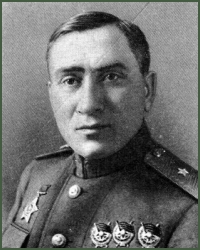The 322nd Rifle Division was a standard Red Army rifle division during World War II. It is most notable for liberating Auschwitz concentration camp as part of the 60th Army on January 27, 1945, in the course of the Vistula-Oder offensive. Prior to this the division also distinguished itself during the second liberation of Zhitomir on the last day of 1943. It received further distinctions for its service in western Ukraine and in Poland. Along with many other distinguished Soviet formations it was disbanded with the coming of peace.
The 3rd Rifle Division was an infantry division of the Soviet Army. It was formed in 1921 in Crimea. The division relocated to Svobodny in the Far East during 1939 and moved to Blagoveshchensk soon after. The division fought in the Soviet invasion of Manchuria and was disbanded in 1946.
The 78th Rifle Division was an infantry division of the Red Army, formed in 1932, in Novosibirsk, in the Siberian Military District. After being used to provide cadres for new divisions, in September 1939 the division was reformed for the second time. In 1940 the division was transferred to Khabarovsk in the Far Eastern Front.
The 101st Rifle Division was a unit of the Soviet Red Army initially formed as a mountain rifle division on 28 August 1938 within the 2nd Separate Red Banner Army in Petropavlovsk-Kamchatsky city.
The 27th Rifle Division was a tactical unit in the Red Army of Soviet Russia and then the Soviet Union, active between 1918 and 1945. First formed during the Russian Civil War on November 3, 1918, as part of 5th Red Army. Commanded by Vitovt Putna, it was transferred to the 16th Red Army in 1920, and took part in the Polish–Soviet War. Defeated in the battles of Radzymin and Ossów, it practically ceased to exist.
The 22nd Motor Rifle Division named for Atamyrat Niyazov is a division of the Turkmenistan Ground Forces. It traces its history to the 344th Rifle Division, an infantry division of the Red Army and the Soviet Ground Forces during World War II and the Cold War.
The 118th Estonian Guards Rifle Division was an elite infantry division of the Red Army and later the Soviet Army. It was formed following the German surrender in June 1945 from the 2nd wartime formation of the 7th Estonian Rifle Division. The division became a brigade in 1946 and became a division again in 1950. It was disbanded in 1956.

The 305th Rifle Division was formed for the first time as a standard Red Army rifle division shortly after the German invasion. It was soon sent north to the Volkhov Front near Novgorod. In the winter of 1942 it participated in an offensive to try to break the siege of Leningrad which ended with it and most of the rest of the attacking force being cut off and gradually annihilated during the spring. A second 305th was raised a few months later in the southern part of the front, where it distinguished itself in the final liberation of Belgorod. It continued in combat through Ukraine and Poland before ending the war near Prague.
The 53rd Rifle Division was an infantry division of the Red Army that served from the early 1930s to the immediate postwar period following World War II.
The 114th Rifle Division began service in July 1939 as a standard Red Army rifle division, as part of the pre-war expansion of the Soviet forces. It was stationed on the Svir River front in the autumn of 1941 and had a relatively uneventful war facing the Finns until the Vyborg–Petrozavodsk Offensive began on June 10, 1944, from which point it saw much more active service. As the Finns were leaving the war the division was transferred to 14th Army in the Arctic, from where it helped to defeat and pursue the German forces from Lapland into Norway.
The 329th Rifle Division was first formed in September 1941, as a standard Red Army rifle division, at Voronezh. This formation was assigned to the Western Front in mid-December as the Soviet winter counter-offensive west of Moscow was developing, but had the misfortune to be cut off and destroyed behind German lines. The division was formed again nearly two years later, this time in 1st Ukrainian Front, and served with distinction with this Front during the final twelve months of the war, winning honors for its roles in the fighting in Poland, Breslau and Berlin before ending the war near Prague.

The 330th Rifle Division was formed as an infantry division of the Red Army late in the summer of 1941, as part of the massive buildup of new Soviet fighting formations at that time. It took part in the defense of Tula in 10th Army soon after reaching the front, and remained in that army for a remarkably long time, until April 1944. It fought in the offensive push into German-occupied western Russia through 1943, then in the destruction of Army Group Center in the summer of 1944, distinguishing itself in the liberation of Mogilyov in June. In 1945 the men and women of the 330th took part in the Vistula-Oder Offensive through Poland and into Pomerania, and then finally in the fighting north of Berlin, ending the war with high distinction, but being disbanded soon after.
The 313th Rifle Division was a standard Red Army rifle division formed on July 15, 1941 in the Udmurt ASSR before being sent to the vicinity of Leningrad, first in the 7th Separate Army east of Lake Ladoga, and later in 32nd Army of Karelian Front, where it spent most of the war facing the Finnish Army in East Karelia. In consequence the division saw relatively uneventful service on this mostly quiet front until the summer of 1944, when it took part in the offensive that drove Finland out of the war. When this was accomplished, the division was redeployed to take the fight into Poland and then into the German heartland in the winter and spring of 1945. It ended the war north of Berlin after compiling a very distinguished record of service.
The 273rd Rifle Division was an infantry division of the Soviet Union's Red Army during World War II, formed twice.
The 3rd Anti-Aircraft Artillery Division was an anti-aircraft artillery division of the Soviet Union's Red Army during World War II.
The 5th Anti-Aircraft Artillery Division was an anti-aircraft artillery division of the Soviet Union's Red Army during World War II.
The 361st Rifle Division formed in August 1941, as a standard Red Army rifle division, at Ufa. It may be considered a "sister" division to the 363rd Rifle Division. After forming, it was assigned to the 39th Army, and played a major role in the near-encirclement of the German 9th Army around Rzhev in the winter counteroffensive of 1941-42. In recognition of its successes it was reorganized as the 21st Guards Rifle Division in March 1942. A new 361st was formed in November 1944, in the far east of the USSR. It saw action during the Soviet invasion of Manchuria in August 1945, staging several crossing operations of the Amur and Songhua Rivers during the first days of the offensive, in recognition of which one regiment was awarded the Order of the Red Banner.
The 366th Rifle Division was an infantry division of the Red Army during World War II, formed twice.

The 172nd Rifle Division was an infantry division of the Red Army during World War II, formed thrice.
The 129th Guards Rifle Division was formed as an elite infantry division of the Red Army in October 1943, based on the 1st formation of the 176th Rifle Division. It was the highest-numbered Guards division designated by the Red Army, although not the last to be formed.


